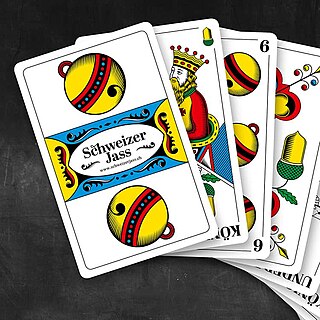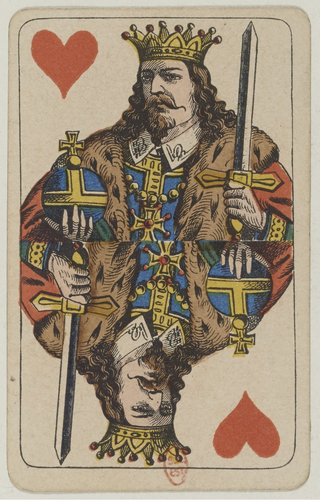
The Banner is a playing card used in Swiss-suited cards and which historically formed part of the standard 36- or 48-card German-suited packs. It is equivalent to a 10, being ranked between a 9 and an Unter (or Under in Swiss German).

The Banner is a playing card used in Swiss-suited cards and which historically formed part of the standard 36- or 48-card German-suited packs. It is equivalent to a 10, being ranked between a 9 and an Unter (or Under in Swiss German).
In German, Banner means “flag” or “banner” and is pronounced /ˈbanɐ/. It is grammatically neuter and its plural is the same: Banner. Historically it was also spelt Panier.
In German-speaking Switzerland, to the east of the Brünig-Napf-Reuss line (the German-speaking part of Switzerland corresponding to the centre and east of the country), the most popular card deck is a pack of 36 cards with the Swiss suit symbols of Acorns, Bells, Roses and Shields and numbered as follows: 6, 7, 8, 9, 10 or Banner, Unter, Ober, King and Deuce.
While the pip cards 6 to 9 display a number of suit symbols corresponding to the number of the card, the 10 follows a different scheme. It has only one example of the suit symbol, much larger than on the other cards, depicted on a banner floating in the wind, [1] [2] [3] which gives the card its name. Like the court cards, the Banners are double-ended in modern packs, the image begin repeated symmetrically about a diagonal line through the card, represented by the flagpole. Older patterns are sometimes single-ended.
The Swiss Banner may be derived from old card games from the German-speaking regions of Europe which were based on a hunting theme, where cards worth ten points were also represented by a banner such as the Ambraser Hofjagdspiel and Stuttgarter Kartenspiel. [4]

In a deck of playing cards, the term face card (US) or court card, and sometimes royalty, is generally used to describe a card that depicts a person as opposed to the pip cards. In a standard 52-card pack of the English pattern, these cards are the King, Queen and Jack. The term picture card is also common, but that term sometimes includes the Aces.

The standard 52-card deck of French-suited playing cards is the most common pack of playing cards used today. In English-speaking countries it is the only traditional pack used for playing cards; in many countries of the world, however, it is used alongside other traditional, often older, standard packs with different suit systems such as those with German-, Italian-, Spanish- or Swiss suits. The most common pattern of French-suited cards worldwide and the only one commonly available in English-speaking countries is the English pattern pack. The second most common is the Belgian-Genoese pattern, designed in France, but whose use spread to Spain, Italy, the Ottoman Empire, the Balkans and much of North Africa and the Middle East. In addition to those, there are other major international and regional patterns including standard 52-card packs, for example, in Italy that use Italian-suited cards. In other regions, such as Spain and Switzerland, the traditional standard pack comprises 36, 40 or 48 cards.

Jass is a family of trick taking, ace–ten card games and, in its key forms, a distinctive branch of the marriage family. It is popular in its native Switzerland as well as the rest of the Alemannic German-speaking area of Europe, Italian South Tyrol and in a few places in Wisconsin, Ohio, California, Oregon and Washington USA.

Karnöffel is a trick-taking card game which probably came from the upper-German language area in Europe in the first quarter of the 15th century. It first appeared listed in a municipal ordinance of Nördlingen, Bavaria, in 1426 among the games that could be lawfully played at the annual city fête. This makes the game the oldest identifiable European card game in the history of playing cards with a continuous tradition of play down to the present day.

Kaiserspiel, also called Kaisern or Cheisärä, is a card game, usually for 4 or 6 players, that is played in parts of Switzerland using a variant of the standard Swiss playing cards with 40 or 48 cards. It is a descendant of Karnöffel, one of the oldest card games known. It is sometimes misleadingly called Kaiserjass, although it has nothing to do with the Jass family of games that are popular in Switzerland.

Johann Kaspar Hechtel was a German businessman, owner of a brass factory in Nuremberg, non-fiction writer and designer of parlour games including the prototype for the Petit Lenormand cartomancy deck. According to published biographies, Hechtel also contributed anonymously to some treatises on physics.

Parts of Swiss German speaking Switzerland have their own deck of playing cards referred to as Swiss-suited playing cards or Swiss-suited cards. They are mostly used for Jass, the "national card game" of Switzerland. The deck is related to the various German playing cards. Within Switzerland, these decks are called German or Swiss German cards.

German-suited playing cards are a very common style of traditional playing card used in many parts of Central Europe characterised by 32- or 36-card packs with the suits of Acorns, Leaves, Hearts and Bells. The German suit system is one of the oldest, becoming standard around 1450 and, a few decades later, influencing the design of the now international French suit system of Clubs, Spades, Hearts and Diamonds. Today German-suited playing cards are common in south and east Germany, Austria, German-speaking Switzerland, Liechtenstein, north Italy, Hungary, Czech Republic, Slovakia, Slovenia, Croatia, Bosnia, northern Serbia, southern Poland and central and western Romania.

The Ober, formerly Obermann, in Austrian also called the Manderl, is the court card in the German and Swiss styles of playing cards that corresponds in rank to the Queen in French packs. The name Ober is an abbreviation of the former name for these cards, Obermann, which meant something like 'superior' or 'lord'. Van der Linde argues that the King, Ober and Unter in a pack of German cards represented the military ranks of general, officer (Oberofficier) and sergeant (Unterofficier), while the pip cards represented the common soldier.

Hearts is one of the four playing card suits in a deck of French-suited and German-suited playing cards. However, the symbol is slightly different: is used in a French deck while is used in a German deck.

Acorns is one of the four playing card suits in a deck of German-suited and Swiss-suited playing cards. This suit was invented in 15th-century German-speaking lands and is a survivor from a large pool of experimental suit signs created to replace the Latin suits. Around 1480, French card makers adapted this sign into clubs in a French deck.

Leaves is one of the four playing card suits in a deck of German-suited playing cards. This suit was invented in 15th century Germany and is a survivor from a large pool of experimental suit signs created to replace the Latin suits. Around 1480, French card makers adapted this sign into Spades in the French pack.

Bells is one of the four playing card suits in a deck of Swiss-suited and German-suited playing cards. Unlike the other German suits, this suit was not adapted by French card makers. In its place, there was initially a suit of red crescents until the suit of Diamonds was added to the French pack. The suit is usually known in German as Schellen, but is sometimes abbreviated to Schell. Cards are referred to as in a French deck e.g. the "9 of Bells", but in German as Schellen 9, or the "Unter of Bells".

Roses or Flowers is one of the four playing card suits in a deck of Swiss-suited playing cards. This suit was invented in 15th century German speaking Switzerland and is a survivor from a large pool of experimental suit signs created to replace the Latin suits. It is equivalent to the Hearts suit in German and French decks.

Shields, also called Escutcheons, is one of the four playing card suits in a deck of Swiss-suited playing cards. This suit was invented in 15th century German speaking lands and is a survivor from a large pool of experimental suit signs created to replace the Latin suits. One example from the mid-15th century is a five-suited deck with the Latin suits plus a suit of shields.

An ace–ten game is a type of card game, highly popular in Europe, in which the aces and tens are of particularly high value.

Kein Stich is a card game, which is well known in the German-speaking parts of the world under various regional names such as Herzeln, King Louis, Kunterbunt ("Multicoloured"), Schwarze Sau, Fritz, Brumseln, Fünferspiel ("Fives"), Lieschen, Lizzy or Pensionisteln ("Pensioners").
The Marriage group is a large family of point-trick card games in which the 'marriage' of two cards, usually a king and queen, plays an important role and attracts a bonus. They are believed to be descended from a German game, Mariagenspiel or Mariage, which dates back to at least 1715. Well-known games in this group include bezique and the national card games of Austria (Schnapsen), Hungary (ulti), France (belote), Switzerland (Jass) and the Netherlands (klaverjas).
Karniffel or Thuringian Karnöffel was a trick-taking card game for four players, playing in pairs, the rules of which were recorded in some detail in a German periodical of the late 18th century where it was described as being played by the Thuringian peasantry. Karniffel was a descendant of the original Karnöffel.